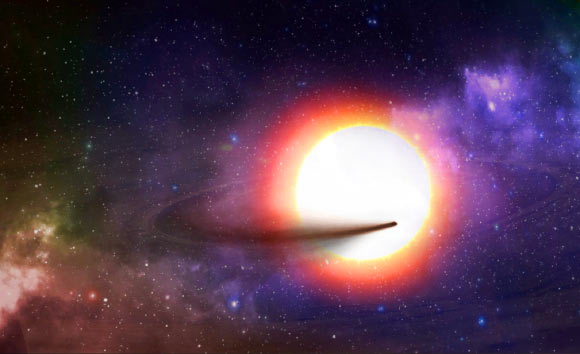Using the ULTRACAM instrument on the 4.2-m William Herschel Telescope, a group of astronomers led by Jakub Bochinski of Open University in Milton Keynes, UK, has observed a massive, comet-like tail of dust coming from the low-mass terrestrial exoplanet KIC 12557548b.

Exoplanet KIC 1255b orbits its parent star followed by a comet-like dust tail. Image credit: Maciej Szyszko.
KIC 12557548b, also known as KIC 1255b, is located in the constellation Cygnus, about 1,500 light years away.
“A single year on KIC 1255b lasts only 16 Earth hours and the whole planet seems to be slowly boiling away under intense heat of its host star,” said Mr Bochinski, who is the first author of the paper published in the journal Astrophysical Journal Letters (arXiv.org preprint).
The KIC 1255b’s surface is heated to over 1,800 degrees Celsius, hot enough to vaporize rock.
As a result, the planet’s outer layers are continuously destroyed, with the evaporating rock creating a comet-like dust tail following the planet in its orbit.
Once every orbit, the planet and the dusty tail pass across the host star, blocking some of its light from our view.
KIC 1255b itself is tiny, similar in size to Mercury – far too small to be seen on its own. The dust cloud, however, is much bigger and blocks up to 1 percent of the star’s light each orbit.
For comparison, the largest planet in our Solar System, Jupiter, would block 1 percent of the Sun’s light in a similar arrangement.
The dust cloud grows and shrinks in size seemingly at random, some of the time disappearing from our view completely.
The measurements made with William Herschel Telescope’s ULTRACAM revealed that the dust cloud, when visible, blocks a slightly larger fraction of the star’s blue light than red light. A similar effect is seen at sunset on Earth when the Sun’s light is scattered by dust in the Earth’s atmosphere, making the remaining light appear reddened.
The exact color-dependence of the scattering by dust can reveal the size and composition of the dust grains.
Ultimately, a series of measurements of KIC 1255b’s dust cloud could reveal the chemical composition of the dust.
Since the dust is made from the rocky surface of the disintegrating planet, the same technique will allow the chemical makeup of the planet’s surface to be measured.
The team plan to make these first exogeological measurements with further observations in summer 2015.
_____
Jakub J. Bochinski et al. 2015. Direct Evidence for an Evolving Dust Cloud from the Exoplanet KIC 12557548 b. ApJ 800, L21; doi: 10.1088/2041-8205/800/2/L21







